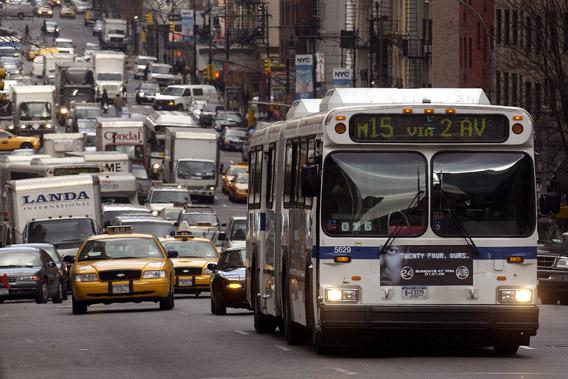When it comes to moving large numbers of people efficiently through urban areas, it’s hard to beat good old-fashioned heavy rail subways and metro lines. But these projects come at a steep price, especially in the United States, and don’t make sense in many areas. Yet, politicians looking for cheaper options too often fall for the superficial idea that anything that runs on train tracks must be a good idea. The smarter strategy in many cases is to look instead at the numerically dominant form of mass transit—the humble bus—and ask what can be done to make it less humble.
After all, relatively few of the things that make bus travel a low-status option have anything to do with the fact that they run on tires, not rails. The main goal of transportation infrastructure is get people where they’re going.
Buses often fall down on the job—not because they’re buses, but because they’re slow. Buses are slow in part because city leaders don’t want to slight anyone and thus end up having them stop far too frequently, leaving almost everyone worse off. Buses also tend to feature an inefficient boarding process. Having each customer pay one at a time while boarding, rather than using a proof-of-payment where you pay in advance and then just step onto the bus, slows things down. That can generate a downward spiral of service quality where slow speeds lead to low ridership, low ridership leads to low revenue levels, and low revenue leads to service that’s infrequent as well as slow. Closing the loop, a slow and infrequent bus will be patronized almost exclusively by the poor, which leads to the route’s political marginalization.
Worst of all, even though a bus is a much more efficient use of crowded space than a private car, it ends up stuck in the same traffic jam as everyone else.
The best light rail systems avoid these pitfalls, giving trains dedicated lanes, a sensible way for customers to pay, and stations that are far enough apart that the train isn’t stopping every three blocks. But low-quality rail can have the exact same problems. The much-hyped H Street streetcar line being constructed in Washington, D.C., is beloved by real estate developers, but is going to leave riders with a train stuck in the exact same traffic jams as the existing buses on the corridor. Detroit’s M-1 streetcar project suffers from the same flaw, making it more of an exercise in civic boosterism than a real transportation improvement. But by the same token, it should be perfectly possible to construct bus lines that have the major virtues of light rail and just happen to run on roads rather than rails. This kind of so-called Bus Rapid Transit (BRT) can typically (though not always) be done at substantially lower cost than new rail construction.
Montgomery County, an affluent Maryland suburb of D.C. with a strong tradition of anti-sprawl politics, is moving closer to a very ambitious BRT push that if successful should serve as a national model. According to the Institute for Transportation and Development Policy’s rating system, only five existing lines in the United States qualify as true BRT and none of them meet the high-end “gold standard” criteria. The current version of the Montgomery plan would create two gold standard corridors, with dedicated busways running in highway medians just as decent light rail lines do. Adding extra concrete to an existing roadway is substantially cheaper than building brand new tracks, so opting for a BRT option will let the county buy more transit bang for its buck.
But the biggest possibility for bus transit wins requires something even more contentious than spending money—repurposing lanes. Virtually every street in America dedicates the majority of its space to private cars, whether as travel lanes or parking lanes. Far and away the cheapest way to speed the movement of people through congested space is to take some of those lanes away from cars and give them to buses. That will decrease your movement of vehicles, but increase your movement of people since buses are a much more efficient use of space. And it can be done at a fraction of the cost of building new transportation infrastructure from scratch.
Of course the problem is people who drive cars won’t like it—the exact same reason that shiny new streetcar lines are often built to drive in mixed traffic. But public officials contemplating mass transit issues need to ask themselves what it is they’re trying to accomplish. If promoting more transit use, denser urban areas, and less air pollution is on the agenda, then annoying car drivers is a feature not a bug. If the idea is to have a make-work job creation scheme or something cool-looking to show off to tourists, buses may not be the best idea. But while upgraded buses clearly isn’t the right solution for every transit corridor in America, it deserves much more widespread consideration as an affordable path to mass transit.
